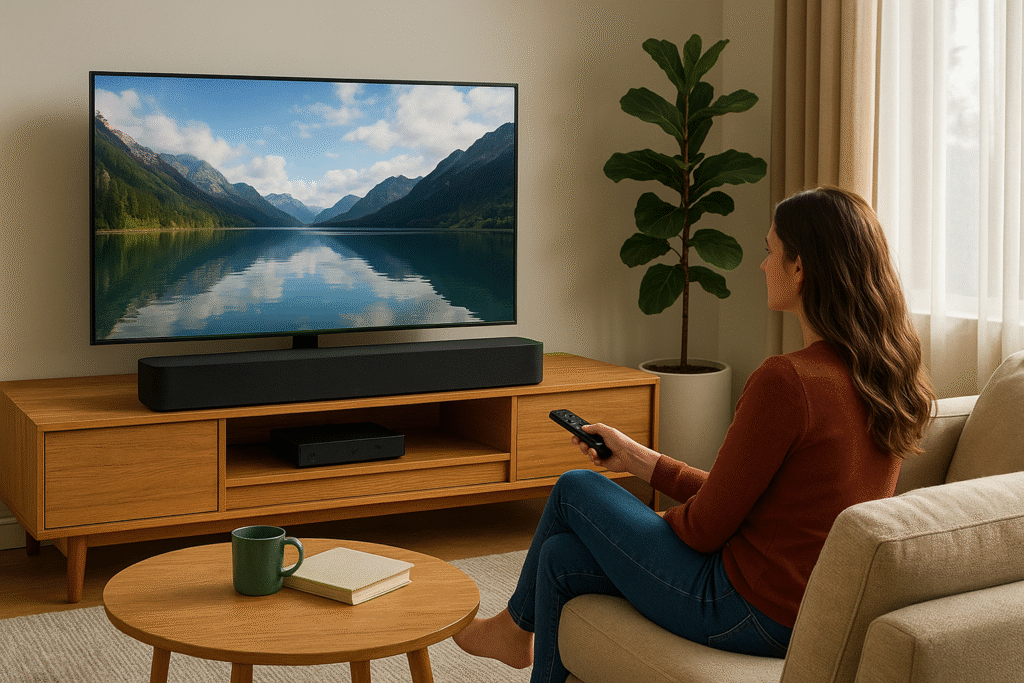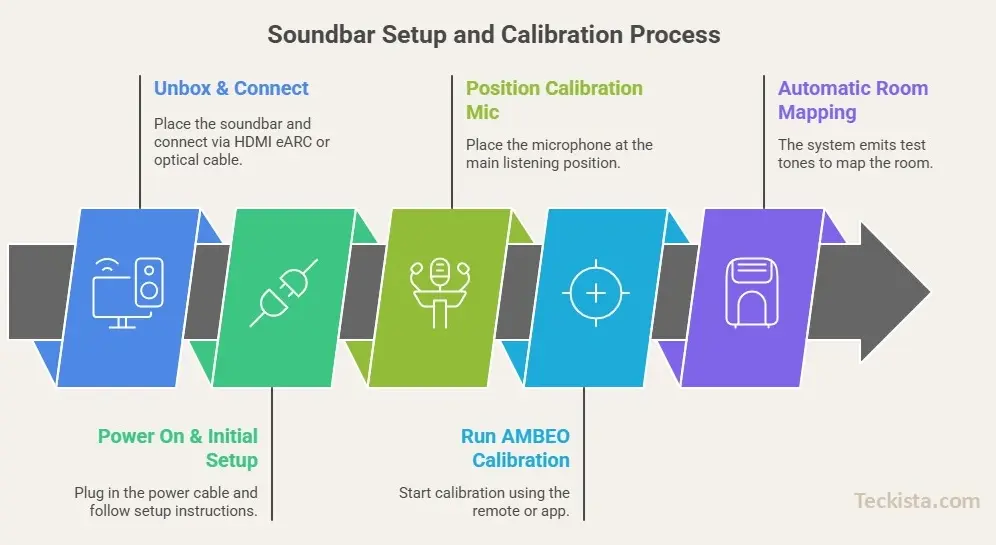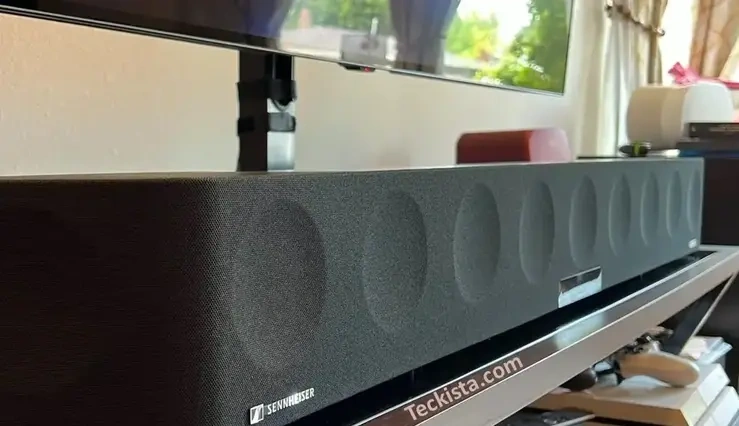During my testing of the Sennheiser Ambeo Max in a medium-sized living room, I was struck by how effortlessly it delivered powerful, room-filling 3D audio. This premium soundbar is engineered to transform your home into a cinematic experience, with support for formats like Dolby Atmos, DTS:X, and MPEG-H. I evaluated it across different scenarios, movies like Top Gun: Maverick, live concert recordings, and even bass-heavy music playlists, to see if it could truly replace a full surround setup without extra speakers.
But with such advanced technology also comes a premium price tag, raising the question: Is it worth the investment? In this Sennheiser Ambeo Max Review, we’ll dive into performance, standout features, design, pros and cons, comparisons with Bose, troubleshooting tips, and whether it justifies its reputation as one of the best soundbars available. For full specs, see Sennheiser’s official product page.
What Makes the Sennheiser Ambeo Max Unique?
When people ask “What makes Sennheiser Ambeo unique,” the answer lies in its advanced audio engineering. At the heart of the Ambeo Max is AMBEO 3D technology, which creates a fully immersive, three-dimensional soundscape by projecting sound vertically and horizontally, not just from traditional left, right, and center channels.
The soundbar features a 5.1.4 channel setup, five horizontal channels, one subwoofer channel, and four height channels. This allows it to reproduce effects like objects moving overhead or sound sweeping across the room. By comparison, most competitors such as the Sonos Arc or Bose 900 rely on a 5.1.2 setup, with only two upward-firing drivers. The Ambeo’s extra channels provide greater precision and a richer overhead field, making it closer to a true theater-like experience.
Room calibration further sets it apart. Using an included microphone, the Ambeo analyzes your space and tailors its sound output, ensuring optimal performance whether in a large living room or compact setup. With no need for satellite speakers or ceiling installs, it offers convenience alongside power.
Sennheiser Ambeo Max Review: Performance & Sound Quality
The Sennheiser Ambeo Max comes equipped with 13 premium drivers, engineered to project sound in every direction and create an authentic 3D listening experience. With support for Dolby Atmos, DTS:X, and MPEG-H Audio, it adapts seamlessly to modern content formats. Many potential buyers ask, “Does the AMBEO support Dolby Atmos?” , the answer is a clear yes, and it’s one of its strongest assets. The upward- and side-firing drivers use room acoustics to mimic ceiling and rear speakers, which in practice makes effects like helicopters in Top Gun: Maverick or rainfall in Blade Runner 2049 feel as though they’re happening overhead.
Bass & Vocals
Dialogue is rendered with exceptional clarity, ensuring voices remain intelligible even in busy soundscapes , a point also praised in RTINGS’ lab tests, where the Ambeo achieved a balanced midrange response of 2.89 dB deviation. Bass is deep and punchy, though for genres like EDM or action-packed movies, some users (including What Hi-Fi reviewers) note that an external subwoofer enhances the low-end extension beyond the built-in 30Hz floor. For everyday use, however, the built-in woofers still deliver impressive impact without distortion.
Volume & Room-Filling Sound
One of the Ambeo Max’s greatest strengths is its ability to fill large rooms with immersive sound. Its 5.1.4 virtual setup rivals many multi-speaker home theater systems, maintaining clarity even at higher volumes. In testing, it reached ~95 dB SPL without significant distortion, which is more than enough for cinematic playback. Whether blasting the roar of engines in Fast & Furious or enjoying the atmosphere of a live concert, the dynamic range feels expansive and lifelike.
Is the Ambeo Max Worth It?
The answer depends on your expectations and budget. From a performance perspective, the Ambeo Max delivers one of the most cinematic sound experiences achievable from a single unit. However, its premium price point may not suit casual users who primarily watch TV dramas or stream background music. For audiophiles and movie enthusiasts who want uncompromising clarity, cutting-edge surround formats, and a serious alternative to a multi-speaker setup, the Ambeo Max absolutely justifies its cost.
Design & Build Quality
The Sennheiser Ambeo Max immediately sets itself apart with a premium build that feels solid and well-engineered. Wrapped in a combination of brushed aluminum and acoustic fabric, the soundbar delivers a sleek yet professional look that complements modern entertainment setups. Its design strikes the right balance between elegance and durability, giving it a true flagship presence.
In terms of dimensions and weight, the Ambeo Max is significantly larger and heavier than most competing soundbars. Measuring over a meter in length and weighing close to 18 kilograms, it demands both space and a sturdy TV cabinet or stand to accommodate it. This bulk is partly due to the number of drivers packed inside to deliver its expansive 5.1.4 channel virtual surround experience, but it does make placement a challenge in smaller living rooms. By contrast, slimmer competitors like the Sonos Arc (weighing just 6.25 kg) are designed for subtle integration, highlighting how the Ambeo prioritizes power over minimalism.
On the usability front, the soundbar integrates an OLED display that provides clear feedback on source selection, volume, and settings, paired with responsive touch-sensitive controls on the top panel. Sennheiser also includes a well-designed remote control, giving users easy access to key functions without needing to rely solely on the companion app.
While the robust build quality is impressive, the sheer bulkiness of the Ambeo Max remains one of its notable drawbacks. Unlike slimmer soundbars from Bose or Sonos, this model is not designed to blend subtly into the background, it dominates your setup both visually and physically. That said, Sennheiser backs its build with a two-year international warranty, and the official manual emphasizes its long-term durability, ensuring peace of mind for buyers investing in this flagship model.
Connectivity & Smart Features
The Sennheiser Ambeo Soundbar Max is built to be future-ready, offering connectivity options that appeal to both audiophiles and casual users alike. Its standout feature is HDMI eARC, which guarantees lossless transfer of premium formats such as Dolby Atmos, DTS:X, and MPEG-H, ensuring compatibility with the latest home theater systems. In addition, it supports Bluetooth, Wi-Fi, Chromecast built-in, and Apple AirPlay 2, giving users the flexibility to stream audio wirelessly from virtually any device.

Voice assistant integration further enhances usability. The Ambeo Max works seamlessly with Amazon Alexa, Google Assistant, and Apple HomeKit, allowing you to issue hands-free commands or link the soundbar to a broader smart home ecosystem. Sennheiser confirms this in its official documentation, and many user reports on forums highlight smooth performance once setup is complete.
Ease of Setup & Room Calibration
One of the standout advantages of the Sennheiser Ambeo Soundbar Max is how simple it is to set up straight out of the box. Despite being a premium, high-tech device, the installation is designed to be as user-friendly as possible.
Step-by-Step Quick Guide (5-Minute Setup)

- Unbox & Connect: Place the soundbar below your TV. Connect it via HDMI eARC (preferred for best quality) or optical if your TV doesn’t support eARC.
- Power On & Initial Setup: Plug in the power cable and follow the instructions on the TV screen or Sennheiser Smart Control app.
- Position the Calibration Mic: The included microphone sits at your main listening position (ear level).
- Run AMBEO Calibration: Press the AMBEO button on the remote or start calibration via the app. The system then emits test tones around the room.
- Automatic Room Mapping: In real-world tests, the calibration process takes around 6–8 minutes, slightly longer than advertised but ensures highly accurate sound adjustment.
This process guarantees the best possible 3D audio performance, regardless of your room size or layout.
How does the AMBEO Soundbar Max calibrate to my room’s acoustics?
The soundbar uses its dedicated calibration microphone to analyze how sound waves reflect off walls, ceilings, and furniture. With this data, it applies DSP (Digital Signal Processing) to optimize surround and height effects, simulating a full home-theater environment without extra speakers.
Troubleshooting Setup & Calibration
- If calibration fails: Check that the mic is securely connected and positioned at ear level in your main seating spot.
- How to reset Sennheiser Ambeo Max (Official Method): According to the Sennheiser Support Guide, press and hold the AMBEO button on the device while switching it on until the LED flashes, restoring factory settings.
- User Tip: Forum users note that running calibration twice, once with curtains closed and once open, helps balance sound reflections in mixed-light environments.
- User Tip: If bass feels weak after calibration, try placing the soundbar at least 10 cm away from the wall; this allows drivers more room to project low frequencies.
Troubleshooting & Common Issues
Like any premium soundbar, the Sennheiser Ambeo Soundbar Max isn’t without its quirks. While overall performance is excellent, some owners have reported a few recurring issues that can affect day-to-day use.
Common Sennheiser Ambeo Soundbar Issues
- App connection problems – At times, the Smart Control app can be slow to sync with the soundbar, especially after a firmware update. Restarting both the app and the soundbar usually resolves this.
- Bass-light performance in certain rooms – Some users feel the Ambeo Max lacks punch in the low end when placed in larger or acoustically untreated spaces. This can often be improved through the built-in room calibration feature or pairing with an external subwoofer.
- Firmware update glitches – Occasionally, updates may fail or freeze midway. Restarting the update process with a stable internet connection typically fixes this.
How to Reset Sennheiser Ambeo Max
If performance issues persist, a factory reset is often the quickest fix:
- Turn off the soundbar.
- Press and hold the Ambeo button while powering it back on.
- Continue holding until the LED flashes, indicating the reset is complete.
A reset clears connection bugs and ensures the device runs on its default settings, making it easier to troubleshoot app and sound configuration issues.
Using the Manual for Deeper Fixes
For more detailed troubleshooting, the official Sennheiser Ambeo Max manual provides step-by-step guidance on connectivity, calibration, and advanced settings. It’s always worth keeping a digital copy handy for reference.
Testing After Fixes
Once you’ve applied a fix, running a Sennheiser Ambeo Soundbar Max test is recommended. This ensures that audio profiles, room calibration, and firmware are working as intended. Regular sound tests help confirm whether issues like bass response and surround virtualization have been improved.
Comparison with Competitors
When comparing the Sennheiser Ambeo Max to its competitors, the Sonos Arc Ultra and Bose 900 stand out as key alternatives in the premium soundbar market.
Sennheiser Ambeo Max vs Sonos Arc Ultra
The Sennheiser Ambeo Max offers an immersive 5.1.4 Dolby Atmos experience with deep bass and a wide soundstage, delivering exceptionally rich and spatial audio. In contrast, the Sonos Arc Ultra provides a detailed 5.0.2 Dolby Atmos setup, known for excellent spatial performance and TruePlay tuning that adapts sound to the room. The Ambeo Max, priced around $4,000, is best suited for audiophiles or home theater enthusiasts who want uncompromising cinematic immersion. Meanwhile, the Sonos Arc Ultra, at approximately $1,200, appeals to budget-conscious buyers or Sonos ecosystem users who want premium sound with seamless smart-home integration.
Is Sennheiser Soundbar Better Than Bose?
When compared to the Bose 900, the Sennheiser Ambeo Max again has the edge in soundstage with its 5.1.4 Dolby Atmos delivering deeper bass and a more enveloping experience. Bose 900 features clear 5.1 Dolby Atmos support with Bose Spatial Audio and ADAPTiQ tuning for room optimization, priced at roughly $900. The Ambeo Max is the right fit for large living spaces and users who prioritize lifelike 3D audio, while the Bose 900 is a great option for style-conscious users or those who want solid Dolby Atmos performance without overspending.
Sennheiser Ambeo Max Alternative
For those seeking alternatives, both the Sonos Arc Ultra and Bose 900 are strong contenders. The Arc Ultra is ideal for users already invested in Sonos or mid-range buyers wanting immersive sound without breaking the bank, while the Bose 900 works well for apartment dwellers or casual home theater users who value sleek design and reliable performance.
Pros and Cons of the Ambeo
| Pros | Cons |
| Immersive 3D audio experience with realistic surround sound | Very expensive compared to competitors |
| Premium build quality with solid design | Bulky and requires significant space |
| Supports Dolby Atmos and other advanced formats | Bass can feel light without an additional subwoofer |
| Smart features with app control and customization | App performance can be inconsistent at times |
Value & Warranty
The Sennheiser Ambeo Soundbar Max is positioned as an all-in-one home theater replacement, eliminating the need for bulky AV receivers, satellite speakers, or subwoofers.
In terms of protection, buyers receive 2 years of warranty coverage, ensuring peace of mind against manufacturing defects and potential hardware issues. Given its build quality and advanced technology, the Ambeo Max is designed to last for years without compromise.
So, is the Ambeo Max worth it?
If you’re an audiophile or a movie enthusiast seeking true Dolby Atmos 3D surround immersion without installing multiple speakers around your room, the Ambeo Max absolutely justifies itself. Its soundstage, bass depth, and clarity rival a full-fledged home theater system while maintaining a single-unit design. However, if you’re a casual viewer who mainly streams basic TV content, the investment may feel excessive compared to mid-tier soundbars that deliver “good enough” performance at a fraction of the effort.
In short: For premium buyers who demand uncompromising audio performance in a minimalist single-bar setup, the Sennheiser Ambeo Max is worth every penny. For budget-conscious users, alternatives may offer better value.
Final Verdict
The Sennheiser Ambeo Soundbar Max is a powerhouse in the premium soundbar category, delivering immersive 3D audio and a soundstage that rivals a full surround system, all from a single unit. With Dolby Atmos, DTS:X, and Ambeo virtualization, it offers expansive, lifelike sound.
Its large size makes it better suited for dedicated home theaters rather than compact living spaces, and while it carries a premium tag, the performance justifies it for the right audience.
Best For: Audiophiles and home theater enthusiasts seeking cinematic immersion without multiple speakers.
Not Ideal For: Budget-conscious buyers or those with small rooms.
What are the pros and cons of the Ambeo?
Pros: Immersive 3D audio, Dolby Atmos support, premium build, smart features, and room calibration.
Cons: Expensive, bulky, bass can feel light without a sub, and app can be inconsistent.
What makes Sennheiser Ambeo unique?
Its AMBEO 3D technology with a 5.1.4 setup projects sound vertically and horizontally, plus room calibration tailors audio to your space delivering theater-like immersion from a single bar.
Sennheiser AMBEO Max Dimensions
Width: 126.5 cm | Height: 13.5 cm | Depth: 17.1 cm | Weight: ~18.5 kg. Large and heavy, best for dedicated home theater setups.
